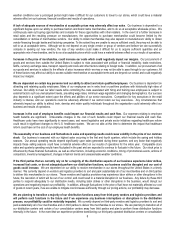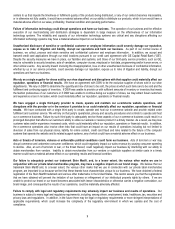Stein Mart 2012 Annual Report Download - page 20
Download and view the complete annual report
Please find page 20 of the 2012 Stein Mart annual report below. You can navigate through the pages in the report by either clicking on the pages listed below, or by using the keyword search tool below to find specific information within the annual report.
18
performance-based incentive related to the final year of our prior co-brand program agreement. Asset impairment and store closing
charges decreased this year due to lower lease termination fees.
Income Taxes. The following table compares income tax expense for fiscal 2011 to fiscal 2010 (dollar amounts in thousands):
2011 2010 Increase
(Restated) (Restated)
Income tax expense
(
benefit
)
12,215$
(
1,688
)
$ 13,903$
Effective tax rate
(
"ETR"
)
38.0%
(
3.1
)
%41.1%
Income tax expense for 2010 was favorably impacted by the reversal of the deferred tax asset valuation allowance established in 2008.
Excluding this favorable tax adjustment, the ETR was 36.0 percent in 2010 due to favorable settlements of state income tax examinations.
During 2011, there was no valuation allowance impact.
Liquidity and Capital Resources
Our primary source of liquidity is the sale of merchandise inventories. Capital requirements and working capital needs are funded
through a combination of internally generated funds, available cash, credit terms from vendors and our revolving credit facility. Working
capital is needed to support store inventories and capital investments for new store openings and to maintain existing stores. Historically,
our working capital needs are lowest in the first quarter and highest at the end of the third quarter and beginning of the fourth quarter as we
build inventories for the holiday selling season.
As of February 2, 2013, we had $67.2 million in cash and cash equivalents and $93.2 million of borrowing availability under our Credit
Agreement. We believe that we will continue to generate positive cash flows from operations on a full year basis. Internally generated
cash, along with our available cash and borrowing capacity under the revolving credit agreement, will provide the means needed to fund
our operations.
The following table presents cash flows data for fiscal 2012, fiscal 2011 and fiscal 2010 (in thousands):
Cash provided by (used in): 2012 2011 2010
(Restated) (Restated)
Operating activities 71,339$ 64,584$ 49,093$
Investing activities (45,426)$ (38,012)$ (28,798)$
Financing activities (52,733)$ (12,237)$ (20,886)$
Cash provided by operating activities
Net cash provided by operating activities was $71.3 million for fiscal 2012 compared to net cash provided by operating activities of $64.6
million for fiscal 2011. Cash provided by operating activities results primarily from operating income and changes in working capital. Cash
provided by operating activities for fiscal 2012 was positively impacted by an income tax refund of approximately $6.6 million. Cash
provided by operating activities for fiscal 2011 includes a positive working capital impact from lengthening vendor payment terms
implemented in early 2011 which did not reoccur in 2012.
Net cash provided by operating activities was $64.6 million for fiscal 2011 compared to net cash provided by operating activities of $49.1
million for fiscal 2010. Cash provided by operating activities results primarily from operating income and changes in working capital. Cash
provided by operating activities for fiscal 2011 includes a positive working capital impact from lengthening vendor payment terms
implemented in early 2011.
Cash used in investing activities
Net cash used in investing activities was solely for capital expenditures. Capital expenditures in 2012, 2011 and 2010 include
approximately $20 million, $20 million and $19 million, respectively, for systems improvements, with the largest portion for our new
merchandise information system. The remaining capital amounts are for opening and remodeling stores, including upgrades to fitting
rooms, lighting, flooring and fixtures. We also replaced our point-of-sale system hardware during 2011, primarily with assets acquired
through capital leases.
We expect to invest approximately $34 million in capital expenditures in 2013, with $14 million for continuing information systems
upgrades, $5 million for distribution center equipment and software and the remainder for new and relocated stores, store remodels and
new fixtures. The cost of opening a new store ranges from $550,000 to $600,000 for fixtures, equipment, leasehold improvements and
pre-opening costs (primarily advertising, stocking and training). Pre-opening costs are expensed at the time of opening. Initial inventory
investment for a new store is approximately $800,000.
























